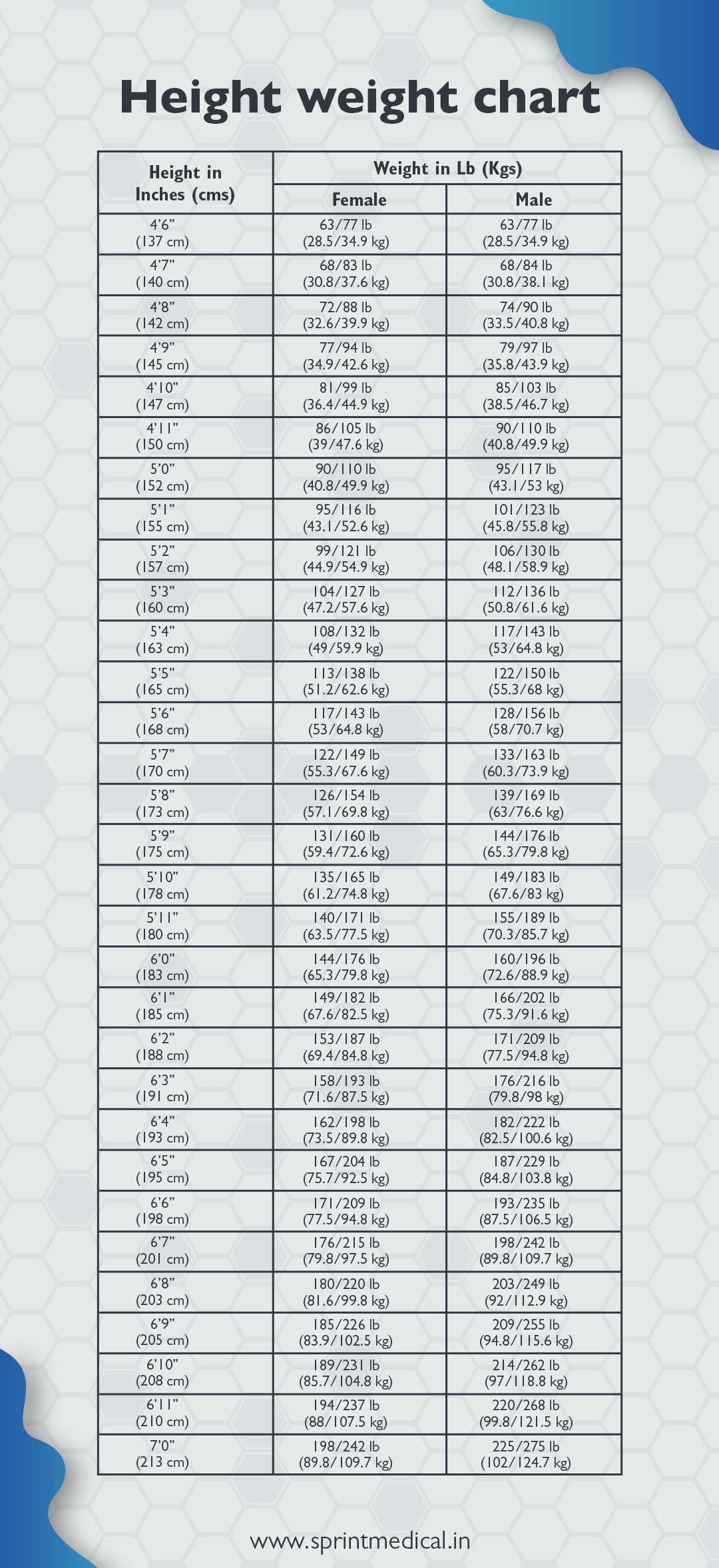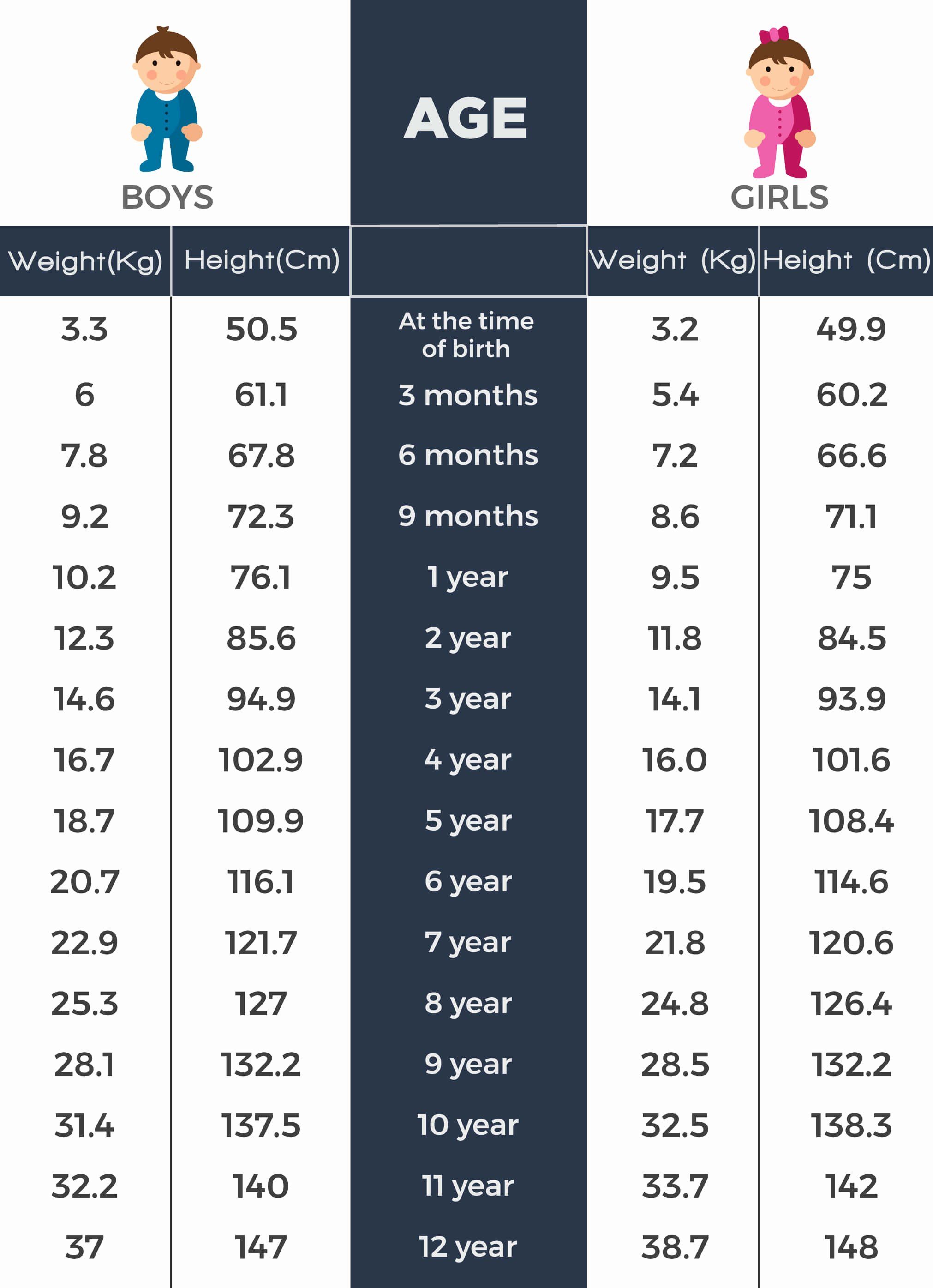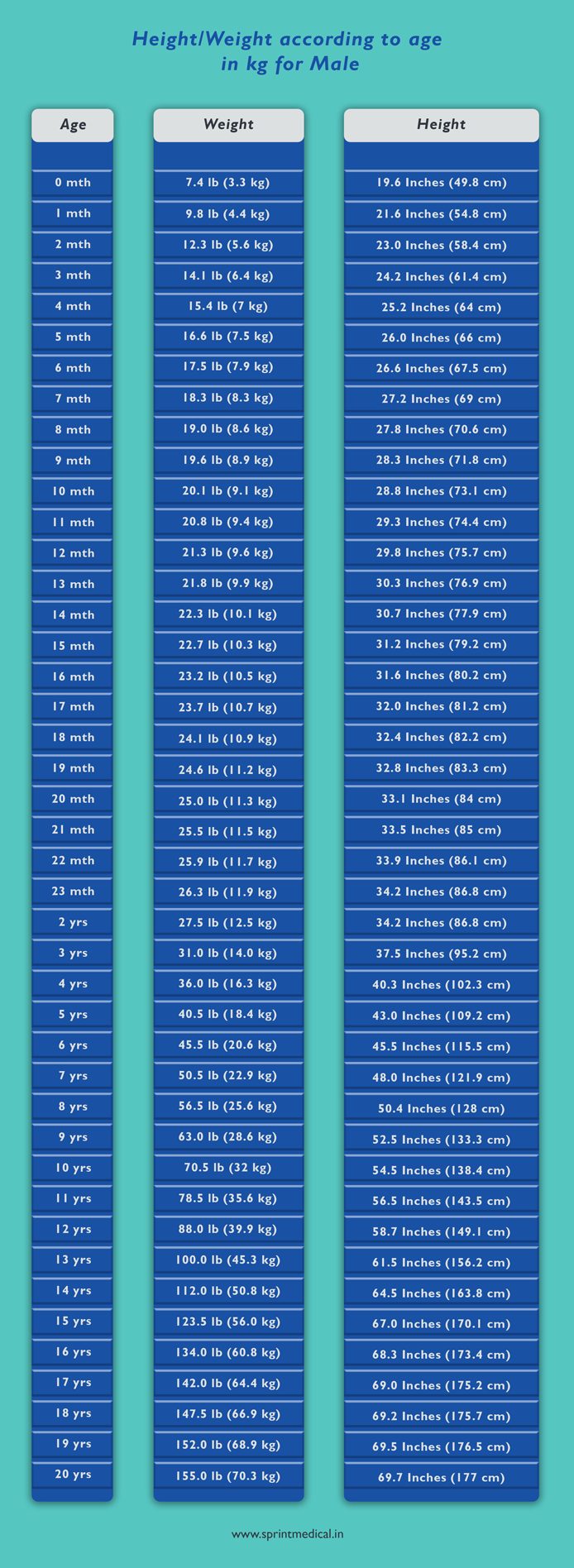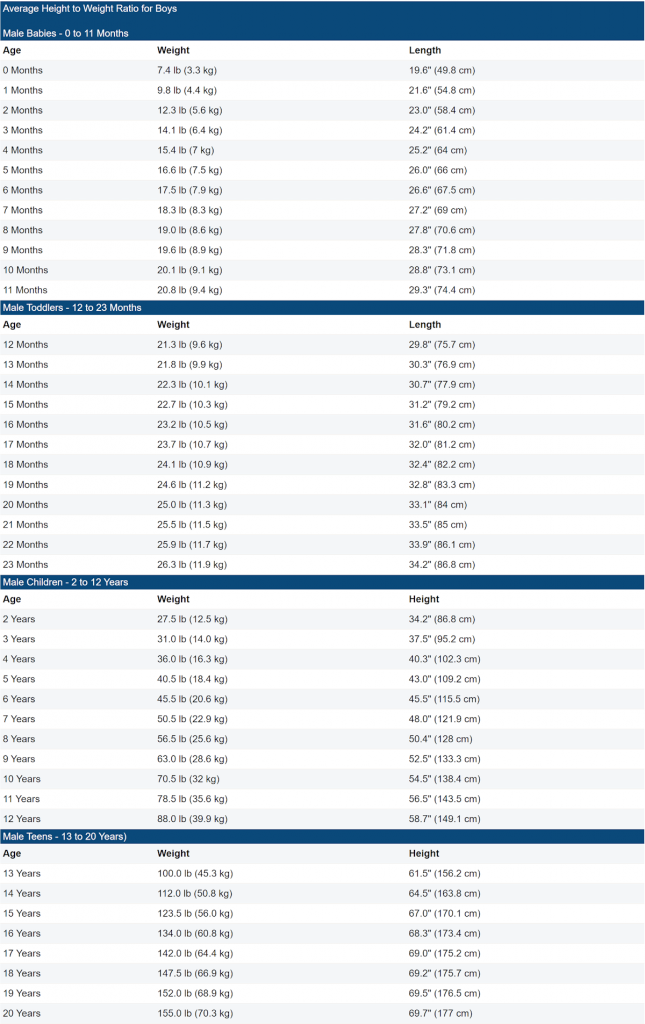A normal height and weight chart is a tool used to assess how healthy a person’s weight is based on their height. It is designed to provide an indication of whether a person’s weight is healthy for their height or not. The chart typically shows height along the left side, and weight along the top. It also typically shows different ranges of healthy weights for people of different heights. A person’s weight is considered healthy when it is within the normal range shown on the chart.
Being overweight or underweight is not healthy and can lead to health complications. It is important to remember that everyone is different and that the chart is just a guide. Body types, lifestyle, and even genetics can all affect how much someone should weigh for their height. It is best to consult a health professional for advice if someone is unsure about their weight or if they have any concerns. They can help to determine the right weight for a person’s height and lifestyle.
average weight and height by age

It highlights the expected average weight and height based on age. For a newborn, the average weight is between 2.5 and 4.5 kg, and the average length is between 45 and 53 cm. As the child grows, the average weight increases to around 10 kg and the length increases to around 74 cm by the age of one. At the age of two, the average weight is between 10 and 16 kg and the average height is between 80 and 86 cm. By the age of three, the average weight increases to around 13 kg, and the average height is between 88 and 98 cm.
As the child grows, the average weight and height continue to increase, with the average weight of an 18-year-old boy estimated at around 70 kg and the average height of an 18-year-old girl estimated at around 163 cm. By the age of 21, the average weight for a male is around 81 kg and the average height is around 176 cm. Female height and weight at the same age are estimated at around 61 kg and 162 cm respectively. Overall, this normal height and weight chart provide useful information about the expected average weight and height for each age group. It helps to identify any issues with development that may require additional medical attention.
How much should a man who is 5’10” weigh?
A man who is 5’10” should generally weigh between 132 and 171 pounds, according to a normal height and weight chart. This range is based on the Body Mass Index (BMI) of 18.5 to 24.9, which is considered to be a healthy weight. For a man who is 5’10”, a BMI of 18.5 would mean a weight of 132 pounds, while a BMI of 24.9 would mean a weight of 171 pounds. It is possible to be outside of this range and still be considered healthy, depending on other factors such as muscle mass, body fat percentage, and overall health. A 5’10” man should talk to his doctor if his weight goes below 132 pounds or above 171 pounds, as this may indicate an underlying health condition.
Being underweight or overweight can cause additional health problems, such as poor heart health, poor immune system, and even depression. Eating a balanced diet and participating in regular physical activity is the best way to maintain a healthy weight. A 5’10” man should consult a doctor and/or a nutritionist to develop a diet and exercise plan tailored to his needs. Overall, a man who is 5’10” should generally weigh between 132 and 171 pounds according to a normal height and weight chart. However, it is important to speak to a doctor about any concerns regarding weight, as this can be an indicator of underlying health issues.
What is the ideal weight for height?
When it comes to understanding what the ideal weight is for your height, it’s important to understand the concept of a normal height and weight chart. This chart is a helpful tool that provides guidance on what is considered a healthy weight for a given height. The chart takes into account age and gender to provide a more accurate reading. Generally speaking, the higher the person’s height, the higher the range of weight they should fall within. For example, an adult who is 6 feet tall should weigh between 130 and 167 pounds, while someone who is 5 feet tall should weigh between 100 and 131 pounds.
The BMI, or body mass index, is another factor to consider when looking at an ideal weight for height. The BMI is a measure of body fat based on height and weight and is considered a better indicator of health than simply body weight. A healthy BMI is between 18.5 and 24.9, which means a person’s weight should fall within the range recommended by the height and weight chart. It is important to remember that the height and weight chart is just a guide and is not meant to be used as a medical diagnosis. It is best to consult with a doctor in order to determine the ideal weight for a person’s individual body composition.
Additionally, it is important to stay active and maintain a balanced diet in order to stay healthy. Overall, the normal height and weight chart is a helpful tool that can be used to understand a person’s ideal weight for their height. However, it is important to take into consideration other factors such as age, gender, and BMI in order to determine what is healthy for an individual.
How much should 6 ft tall guy weigh?
According to a normal height and weight chart, a 6-foot-tall guy should weigh between 137 and 183 pounds. This range is for a healthy weight for the 6-foot male. However, it is important to remember that individual body types and genetic factors can affect what is considered a ‘normal’ weight. Factors such as muscle mass, body fat percentage, age, and gender can play a role in what is considered a healthy weight for a 6-foot male. For example, a 30-year-old male who is 6 foot tall could weigh more than a 20-year-old 6-foot male and it would still be considered in the healthy range.
The best way to determine if a 6-foot male is at a healthy weight is to consult a physician or nutritionist. They will be able to help determine the best weight for the individual based on all the factors that can affect it. In order to maintain a healthy weight, a 6-foot male should incorporate a balanced diet and regular exercise. Eating healthy, balanced meals and being mindful of portion sizes can help keep an individual’s weight within the healthy range. Additionally, incorporating regular physical activities such as walking, running, swimming, or any other physical activity can help maintain a healthy weight for a 6-foot male.
Overall, it is important to remember that individual body type and genetic factors play a large role in determining a 6-foot male’s optimal weight. Consulting a physician or nutritionist can help to determine the best weight for an individual and incorporating a balanced diet and regular exercise can help to maintain a healthy weight.
What BMI is normal?
A normal height and weight chart is a helpful tool to use when evaluating a person’s BMI. The normal height and weight chart are typically divided by age and gender, as BMI can be different depending on the age and gender of a person. For example, a female between the ages of 20-29 should have a BMI between 18.5 and 24.9, whereas a male between the same age should have a BMI between 18.5 and 26.4. BMI is calculated by dividing a person’s weight in kilograms by their height in meters squared. A BMI of 18.5 to 24.9 is considered to be in the normal range, whereas a BMI of 25 or greater is considered overweight and a BMI of 30 or greater is considered to be obese.
It is important to note that BMI alone should not be used as an indicator of someone’s health. Other factors such as activity level, muscle mass, and body composition should be taken into consideration when assessing a person’s health. Overall, a normal height and weight chart can be a useful tool to use when evaluating a person’s BMI. It is important to remember that BMI is only one factor to consider when evaluating a person’s health.
height and weight and age chart

A normal height and weight chart provide a range of healthy heights and weights for people of all ages. This chart is used to determine if a person’s height and weight are within the normal range and if they are developing properly. The chart is broken down by age groups, with a range of height and weight measurements appropriate for each age. For example, a healthy weight for a 3-year-old child is between 31 and 36 pounds, while a healthy weight for a 10-year-old child is between 57 and 97 pounds. The chart also includes a range for height based on the child’s age.
A healthy height for a 5-year-old child is between 40 and 44 inches, while a healthy height for a 12-year-old child is between 60 and 63 inches. In addition to providing a range of normal heights and weights, the chart also helps determine if a child is growing at a healthy rate. For example, a healthy weight gain for a 2-year-old is between 4 and 10 pounds per year, while a healthy weight gain for a 12-year-old is between 3 and 7 pounds per year. It is important to remember that this chart is only a guideline and that a child’s height and weight may be outside of the normal range without any cause for concern. Your child’s doctor can help you determine if your child’s height and weight are within a healthy range for their age.
Is weight based on height or age?
Normal height and weight charts are designed to provide a general overview of appropriate weight for a person based on their age and height. Generally, height is thought to have an inverse relationship with weight; the taller a person is, the less they usually weigh. However, age also plays a role in determining a person’s healthy weight range. Weight is typically higher in younger people, and decreases with age. For instance, a 10-year-old girl may weigh more than a woman of the same height in her 20s because she hasn’t reached her peak in height yet.
As she gets older and grows taller, her weight should decrease. While height and age are both important factors in determining healthy weight, the most important measure of a person’s weight is their body mass index (BMI). This is a ratio of a person’s weight to their height and can be used to determine if someone is underweight, normal weight, overweight, or obese. Ultimately, both height and age should be taken into account when looking for a normal weight range for a person. Height is an important indicator, as taller people typically weigh less, but age is also a factor to consider. A person’s BMI should always be the main indicator used to evaluate someone’s weight.
What’s the right weight for my height?
Generally, a healthy weight for an adult is calculated using the body mass index, or BMI. To calculate your BMI, you need to divide your weight in kilograms (kg) by your height in meters squared (m2). If your BMI is within the range of 18.5 to 24.9, you are considered to be in a healthy weight range. Your ideal weight can also be estimated by taking your height and frame size into account, as well as your age and gender. Generally, women who are shorter than 5’5″ should aim to weigh between 100 and 132 pounds, while men who are shorter than 5’5″ should aim to weigh between 106 and 140 pounds.
It’s important to remember that this is only a general guide and that there is no ‘ideal’ weight. Everyone’s body and lifestyle is different, so it’s important to talk to your doctor if you have specific concerns about your weight. Ultimately, the best way to determine the right weight for your height is to maintain a healthy lifestyle. Eating a balanced diet and exercising regularly can help you maintain a healthy weight and ensure you get the nutrition you need to stay healthy.
What is the average weight of a 6-year-old?
The average weight of a 6-year-old varies depending on the size and frame of the child. According to the normal height and weight chart, the average weight for a 6-year-old girl is 43.2 pounds, and the average weight for a 6-year-old boy is 47.1 pounds. This average weight is also dependent on the child’s height. Generally, a 6-year-old girl should measure between 42-47 inches in height, and a 6-year-old boy should measure between 45-50 inches in height. If a 6-year-old is below or above these average heights, their corresponding weight should be adjusted accordingly.
A 6-year-old may also fall into the healthy range for weight but still not meet the average. As long as the child’s weight falls within the healthy range according to their height and frame, there is no need to worry. It is important to remember that every child is different, and all children grow and develop at different rates. Therefore, there is no one-size-fits-all answer to the average weight of a 6-year-old. The most important thing is to ensure that your child is healthy and that their weight is within an acceptable range for their age and frame.
What is the average height of a 19-year-old?
The average height of a 19-year-old can be determined through the use of a normal height and weight chart. When following these charts, it is important to keep in mind that different charts can give slightly different results. For boys, the average height at 19 years is around 68 inches tall. For girls, the average height at 19 years is around 65.5 inches. These figures are a good starting point, however, it is important to note that individual heights can vary greatly, and are affected by factors such as genetics, nutrition, and environment.
In addition to height, the normal height and weight chart also provide information on other physical characteristics such as body mass index (BMI). BMI is a measure of body fat and is calculated using height and weight. BMI is an important factor to consider when determining whether a 19-year-old is of normal height and weight. When using a normal height and weight chart to determine the average height of a 19-year-old, it is important to remember that these charts are not exact, and individual heights can vary significantly. It is also important to take into consideration other factors such as BMI and genetics when determining whether a 19-year-old is of normal height and weight.
average height weight chart by age

Generally speaking, a normal height and weight chart will show a range of values for each age group. In general, a child’s height and weight should increase steadily over time. In a normal height and weight chart, you will see an average of height and weight for males and females at different ages. For example, a 10-year-old girl may have a height of around 58 inches and a weight of 82 pounds, while a 10-year-old boy may have a height of 61 inches and a weight of 95 pounds. It is important to note that these values are averages and that your child may not necessarily fit the normal height and weight chart.
You should also talk to your doctor or healthcare provider if you are concerned about your child’s growth or if they are significantly above or below average height and weight. The average height and weight chart by age is a helpful tool to monitor the growth and health of children and adults. It provides valuable information about how a person’s height and weight should increase over time.
However, it is important to remember that these values are averages, and each individual person may be different. If you have any concerns about your child’s growth, talk to your doctor or healthcare provider.
How to determine your BMI score?
Determining your body mass index (BMI) score can help you understand your health and fitness level. By using a normal height and weight chart, you can easily calculate your BMI score. In this chart, the height is indicated in meters and the weight is indicated in kilograms. To calculate your BMI score, divide your weight in kilograms by your height in meters squared. If your BMI is below 18.5, you are considered underweight.
If your BMI is between 18.5 and 25, you are considered to be at a healthy weight. Lastly, if your BMI is over 25, you are considered overweight. It is important to remember that these ranges are general guidelines and that you should also speak to your doctor to discuss your personal health and fitness goals.
What are the average height and weight of a 16-year-old male?
The average height and weight of a 16-year-old male may vary somewhat depending on the individual. According to the normal height and weight chart, the average 16-year-old male should be between 60-83 inches tall and weigh around 130-175 pounds. However, these are only averages and some boys may be taller or shorter, and weigh more or less than this. It is important to remember that the average height and weight of a 16-year-old male can vary due to individual differences. Some boys may hit certain milestones like puberty earlier or later than others, which can also influence their height and weight.
It is recommended that 16-year-old males talk to their doctor about their height and weight to make sure they are healthy and growing normally. If a 16-year-old is outside of the normal range, they may need to make lifestyle changes such as eating a healthy diet or exercising more often in order to get to a healthier weight. It is also important to remember that the normal height and weight chart is just a guideline. Each individual’s body is different and a healthy weight for one person may be different than a healthy weight for another person. Ultimately, the average height and weight of a 16-year-old male according to the normal height and weight chart is between 60-83 inches tall and 130-175 pounds. However, it is important to remember that individual differences can affect this and it is best to talk to a doctor to find out what is healthy for you.
What is the average height and weight of an 18-month-old girl?
A normal height and weight chart for an 18-month-old girl typically shows that the average weight is around 25.5 pounds and the average height is around 31 inches. This is a general guideline; however, some children may be slightly taller or shorter and heavier or lighter than this range. It is important to remember that children grow and develop at different rates. While your child may not fit into the average height and weight chart for an 18-month-old girl, as long as they’re growing steadily and in line with their own growth curves, this is likely a sign of healthy development. It is a good idea to keep track of your child’s growth and discuss any concerns with your pediatrician.
With regular checkups, your doctor can monitor your child’s height and weight to make sure they are developing normally. You may also want to consider checking your child’s body mass index (BMI). This can help provide a more accurate picture of your child’s individual health. Additionally, you can use BMI as a tool to help monitor your child’s growth over time. Overall, the average height and weight for an 18-month-old girl are 25.5 pounds and 31 inches respectively. However, it is important to remember that all children are unique and that healthy growth can look different for each child.







